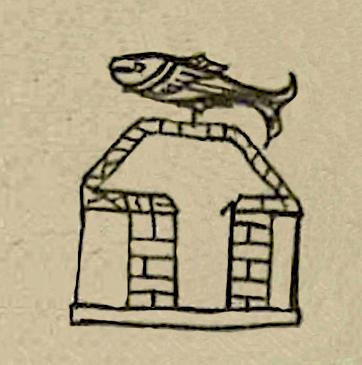Michcalco (T2681:6:2r)
This compound glyph represents the place name Michcalco, which is in the area of Chalco. It consists of a black and white image of a fish (michin) atop a building (calli) in frontal view sited on another element that is outlined in black and shaded around its edges in a green wash (see the historical contextualizing image). The calli displays what must be some European influence, in that instead of being in the more common profile view with a flat roof, this one is a frontal view with a peaked roof. Even so, it is not a standard depiction of a human habitation (unlike two other structures on the same manuscript), particularly in its lacks a lintel over the doorway opening. Gordon Whittaker (personal communication, April 20, 2023) suggests that this building had a different purpose, possibly connected with fisheries in the area (perhaps a tank where live fish were kept).
Robert Haskett
This compound place glyph for Michcalco appears on a pictorial manuscript submitted by indigenous petitioners from the pueblo of Cuitlahuacan, Chalco, sometime before March 24, 1579, when a canoe-born investigation was carried out of a chinampa (a constructed, raised field in the shallow waters of a laguna or lake) near the sujeto (dependency) of Santa María Magdalena Michcalco (also called an estançia). The community’s land tenure was being threatened by an effort of a man named Bartolomé Arias to gain a grant of this property from the viceregal authorities (an effort that ultimately failed). While Arias and several witnesses who supported him claimed that the parcel was filled with grass, used by him to pasture horses, witnesses for Santa María Magdalena and Cuitlahuacan asserted that it was customarily planted with maize, chili, and other agricultural crops. On the pictorial itself, Michcalco is situated among bar-shaped figures that represent chinamitl (also called chinampas) agricultural plots and an alphabetic gloss that says “Michcalco Santa Maria Magdalena” (see the historical contextualizing image, below). The black-edged green figure seems to serve as s a semantic element that implies the locative -co, which is otherwise not specifically illustrated (a similar element on the map lacks any other features, but is glossed as tierras as opposed to the chinampa elments, which are glossed as camellones, or "ridges"). Areas of human habitation seem to be represented, in part, by buildings situated on black-outlined, ovoid elements with green shading that are not anything like the chinampan elements. In fact, one of the Spanish records associated with the map contains the statement that Michcalco is on something “like a kind of island” (folio 4r). Whether this is a natural feature, a more substantial kind of chinamitl, or a combination of these things is not entirely clear. While there is a short Nahuatl-language petition included among the folios of this case (14r), it does not mention specific crops, and it uses the loan solar (lot) rather than chinamitl or chinampa to describe it. On the other hand, a Spanish-language report of a second canoe-borne investigation (fol. 18r) states that the parcel in question is “que los indios llaman chinampas” (“what the Indians call chinampas”) and includes a brief description of how such things are built.
Robert Haskett
michcalco
Michcalco
Robert Haskett
1579
Robert Haskett
place glyph, houses, casas, fish, peces, pez, pescado, chinampa, chinamitl, solar, nombres de lugares

mich(in), fish https://nahuatl.wired-humanities.org/content/michin
cal(li), house, building, https://nahuatl.wired-humanities.org/content/calli
En el [Lugar del] Pez-Casa
Robert Haskett and Stephanie Wood
Single-page codex, Archivo General de la Nación, México, Ramo de Tierras Vol. 2681, Exp. 6, Fol. 2r.
The Archivo General de la Nación (AGN), México, holds the original manuscript. This image is published here under a Creative Commons license, asking that you cite the AGN and this Visual Lexicon of Aztec Hieroglyphs





